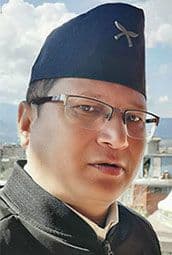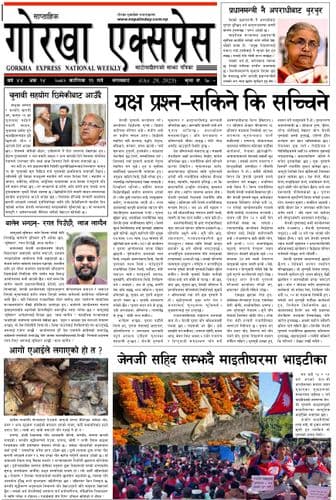
By mid-2025, Nepal’s center of power has once again reached a critical point of transformation. The political structure that emerged after the establishment of the republic is now under the pressure of complex internal and external alliances. On one hand, the Nepali Army appears to be attempting to reestablish former President Bidya Devi Bhandari as a strong national leader. On the other hand, the U.S. strategy seems to be positioning both KP Sharma Oli and Bidya Bhandari as an alternative power package. During this time, there is credible basis to believe that covert dialogues are underway among the army, political forces, and the former monarchy in coordination with RSS-backed networks.
Reliable sources confirm that certain factions within the Nepali Army are working to bring Bidya Bhandari into the leadership of the CPN-UML. This is not merely an internal power struggle; it is a strategic preparation for a future power equation. While Oli’s leadership of UML is still useful from the American perspective, his limitations are becoming increasingly evident—especially due to his rigid stance on nationalism, which has created discomfort for the U.S. Conversely, although Bhandari appeared to oppose the MCC during her presidency, she had actively collaborated with military and covert networks, making her an influential figure with deep connections. This makes her a well-positioned alternative leader.
The U.S. appears to be adopting a particular strategy in Nepal—a dual-track balance. On one hand, they project Oli as the primary contender for power; on the other, they support Bhandari as a potential “soft nationalist” leader. After the implementation of the MCC and with Nepal becoming entangled in the BRI domain, the U.S. has crafted a dual approach: direct control through Oli and indirect strategic stability through Bhandari. This allows them to remain active in both models—regime change or internal intervention.
In this strategy, the role of the RSS cannot be overlooked. The RSS's vision for Nepal is clear: reestablishing a Hindu state, reviving the former monarchy’s cultural role, and uniting nationalist forces. Since 2015, the RSS–RAW network has been cooperating with factions inside the Nepali Army to back the monarchy, and now these efforts are being reorganized in a new form.
Looking at Nepal’s internal structure, the role of the Nepali Army has become increasingly decisive. Once seen as a constitutional guardian, the army is now becoming a behind-the-scenes manager of power balance. Its traditional ties with the monarchy, mutual understanding with Bidya Bhandari, and its shrewd dialogue with foreign powers have positioned the army as a “bridge of power equilibrium.” This situation has created two internal currents within the military leadership—one that remains committed to the constitution and democratic norms, and another that believes the army can intervene during a national crisis.
Similarly, the internal structure of UML is now heading toward acute conflict. Bhandari’s emergence is not merely a personal ambition to chair the party but a strategic projection—her rise signifies that Oli is weakening, which is a message the Americans may be trying to convey. This division creates two factions within the UML: one led by Oli representing a hardline nationalist current, and the other by Bhandari advocating for an institutional and consensus-based approach. This not only risks splitting the party but also opens the door for increased foreign control over Nepal’s political equilibrium.
Discussions around reinstating a ceremonial monarchy are also gaining momentum in this context. Within the military, the former monarchy, and among RSS-backed intellectual circles, the idea is growing that the king should once again symbolize the nation—representing Hindu-Buddhist cultural identity. Among conservative circles, this idea is no longer just a debate; it has already evolved into a strategic plan.
If the army-led restructuring of power combines a ceremonial monarchy, a nationalist leader (Bhandari), and a coalition government, a new political structure could be introduced through constitutional amendment.
The ultimate outcome of such an alignment is a deviation from the constitutional path. If the alliance between the army, former president, ex-monarchy, and foreign powers succeeds in breaking UML from within, weakening the Nepali Congress, and executing a soft, covert intervention that compromises national sovereignty, Nepal could turn into a strategic colony. Even if the people do not feel a direct threat, the country’s policy independence would begin to erode.
In this 2025 scenario, Nepal is being driven toward three possible trajectories. First, UML gets divided, and a new political organization is formed under Bhandari’s leadership, which easily embraces U.S. and Indian strategic interests. Second, the ceremonial monarchy is reinstated symbolically, pushing the Hindu state agenda forward toward constitutional revision. Third, the Nepali Army makes a decisive intervention in the power balance or establishes a shadow control structure behind the scenes.
All three of these paths are perilous for Nepal. Nationalism, independence, and sovereignty are no longer just slogans—they have now transformed into strategic imperatives. In this context, what’s required is the creation of a robust alternative nationalist force, elevation of political awareness among the public, and strategies to confront foreign interference through legal, institutional, and intellectual means. A political restructuring under the guise of foreign aid or military guardianship is unacceptable.
Nepal is now at a critical crossroads. The path forward will not always be democratic; sometimes, decisions must be unpopular yet historic. This is the time—to expose foreign designs, unite patriotic leaders, and return the entire political architecture back into the hands of the people.



